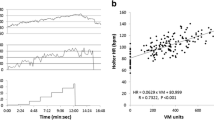Abstract
Chronotropic incompetence (CI) is common in heart failure (HF) patients and is associated with worsening outcome. Detecting and tracking functional CI during activities of daily living could provide insight into its contribution to HF symptoms and facilitate effective HF patient management. HF patients (n = 180, NYHA Class III/IV, ejection fraction (EF) ≤40%) were enrolled in a multi-center prospective monitoring study and had an external multi-sensor system applied to the chest and replaced weekly during a 90-day study. Medical information was collected at baseline and study close. Heart rate, respiration, activity, and body fluid data from the system were transmitted at regular intervals and used for offline analysis. Patients were primarily male (70%), with 61 ± 13 years mean age, 25 ± 5 kg/m2 BMI, and 28 ± 7% EF. By correlating age-adjusted activity level and heart rate adaptation with a proprietary algorithm, functional CI was detected in 45% and ruled out in 29% of patients under conditions of daily living. In the remaining patients (26%), functional CI assessment was indeterminate due to insufficient age-adjusted activity level. Functional CI and No-CI groups were not significantly different in terms of baseline demographics, characteristics or HF outcome over the study period. β-blocker use was 16% in the CI group and 82% in the no-CI group (p < 0.001), and therefore, could not explain the manifestation of functional CI. This proof-of-concept study suggests that a chronotropic response that may be functionally debilitating during activities of daily living in HF patients can be detected and tracked in a point-of-care telemonitoring approach using a non-invasive, adherent device.


Similar content being viewed by others
References
Lloyd-Jones, D., Adams, R., Carnethon, M., De Simone, G., Ferguson, T. B., Flegal, K., et al. (2009). Heart disease and stroke statistics—2009 update: a report from the American Heart Association Statistics Committee and Stroke Statistics Subcommittee. Circulation, 119, 480–486.
Clark, A. L., & Coats, A. J. (1995). Chronotropic incompetence in chronic heart failure. International Journal of Cardiology, 49, 225–231.
Colucci, W. S., Ribeiro, J. P., Rocco, M. B., Quigg, R. J., Creager, M. A., Marsh, J. D., et al. (1989). Impaired chronotropic response to exercise in patients with congestive heart failure. Role of postsynaptic beta-adrenergic desensitization. Circulation, 80, 314–323.
Azarbal, B., Hayes, S. W., Lewin, H. C., Hachamovitch, R., Cohen, I., & Berman, D. S. (2004). The incremental prognostic value of percentage of heart rate reserve achieved over myocardial perfusion single-photon emission computed tomography in the prediction of cardiac death and all-cause mortality: superiority over 85% of maximal age-predicted heart rate. Journal of the American College of Cardiology, 44, 423–430.
Elhendy, A., Mahoney, D. W., Khandheria, B. K., Burger, K., & Pellikka, P. A. (2003). Prognostic significance of impairment of heart rate response to exercise: impact of left ventricular function and myocardial ischemia. Journal of the American College of Cardiology, 42, 823–830.
Goraya, T. Y., Jacobsen, S. J., Pellikka, P. A., Miller, T. D., Khan, A., Weston, S. A., et al. (2000). Prognostic value of treadmill exercise testing in elderly persons. Annals of Internal Medicine, 132, 862–870.
Brubaker, P. H., & Kitzman, D. W. (2007). Prevalence and management of chronotropic incompetence in heart failure. Current Cardiology Reports, 9, 229–235.
Witte, K. K., Cleland, J. G., & Clark, A. L. (2006). Chronic heart failure, chronotropic incompetence, and the effects of beta blockade. Heart, 92, 481–486.
Khan, M. N., Pothier, C. E., & Lauer, M. S. (2005). Chronotropic incompetence as a predictor of death among patients with normal electrograms taking beta blockers (metoprolol or atenolol). The American Journal of Cardiology, 96, 1328–1333.
Brubaker, P. H., Joo, K. C., Stewart, K. P., Fray, B., Moore, B., & Kitzman, D. W. (2006). Chronotropic incompetence and its contribution to exercise intolerance in older heart failure patients. Journal of Cardiopulmonary Rehabilitation, 26, 86–89.
Dresing, T. J., Blackstone, E. H., Pashkow, F. J., Snader, C. E., Marwick, T. H., & Lauer, M. S. (2000). Usefulness of impaired chronotropic response to exercise as a predictor of mortality, independent of the severity of coronary artery disease. The American Journal of Cardiology, 86, 602–609.
Lauer, M. S., Francis, G. S., Okin, P. M., Pashkow, F. J., Snader, C. E., & Marwick, T. H. (1999). Impaired chronotropic response to exercise stress testing as a predictor of mortality. Journal of the American Medical Association, 281, 524–529.
Lauer, M. S., Okin, P. M., Larson, M. G., Evans, J. C., & Levy, D. (1996). Impaired heart rate response to graded exercise. Prognostic implications of chronotropic incompetence in the Framingham Heart Study. Circulation, 93, 1520–1526.
Dafoe, W. A. (1999). Tables of energy requirements for activities of daily living, household tasks, recreational activities, and vocational activities. In F. J. Pashkow & W. A. Dafoe (Eds.), Clinical cardiac rehabiliation, a cardiologist’s guide (pp. 515–524). Baltimore: Williams & Wilkins.
Author information
Authors and Affiliations
Corresponding author
Rights and permissions
About this article
Cite this article
Katra, R.P., Chakravarthy, N. & Libbus, I. Remote At-Home Detection and Monitoring of Functional Chronotropic Incompetence in Heart Failure Patients. J. of Cardiovasc. Trans. Res. 4, 14–20 (2011). https://doi.org/10.1007/s12265-010-9227-1
Received:
Accepted:
Published:
Issue Date:
DOI: https://doi.org/10.1007/s12265-010-9227-1




